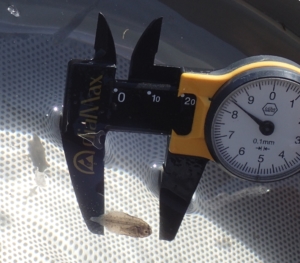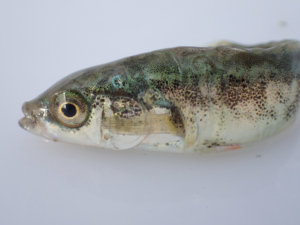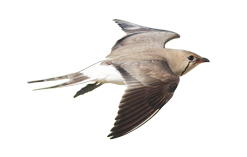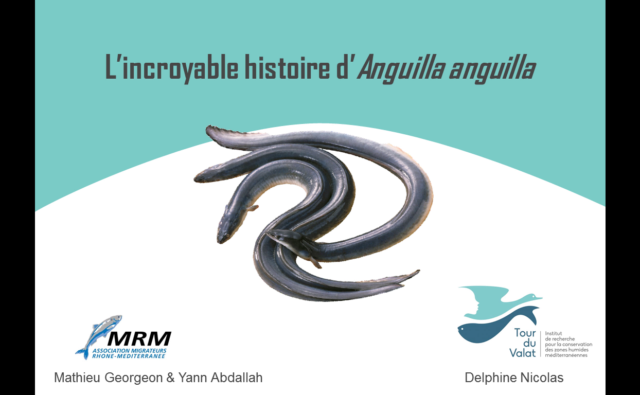Fish communities in the Camargue
Objectives
The hydraulic system of the Camargue Delta has functioned in a completely artificial way for decades: freshwater inputs are mainly controlled by pumping from the Rhone for irrigation, and marine inputs by opening the floodgates at the Pertuis de la Fourcade. This project seeks to characterise and explain the temporal and spatial structure and dynamics of fish communities throughout the Camargue, and those of decapod crustaceans, in function of environmental conditions, hydraulic management of the system, and the introduction of new species, such as the Wels Catfish, and the Topmouth Gudgeon.

Actions and methodology
The project was initiated in 1976, involving a large number of studies aimed at better understanding the functioning and dynamics of freshwater and brackish-water fish populations, and studying the life history traits of numerous species.
Three monthly long-term monitoring programmes were set up by Alain Crivelli back in 1993:
- in the Fumemorte drainage canal (1993 to present)
- at la Capelière in the Etang de Vaccarès lagoon (1993 to 2002, 2005, 2008, 2018, 2019, 2022, 2025)
- at le Malagroy in the Etang des Impériaux lagoon (1996 to 2002, 2005, 2008)
These sampling campaigns are conducted using a fixed-station method with passive fishing gear (hoop nets, capéchade trap nets) and characterise the populations in terms of species diversity, abundance, biomass, and size range.
Monthly sampling of the fish population in the Fumemorte canal has been performed continuously since 1993. During the first year of monitoring, the Wels Catfish (Silurus glanis), an opportunistic super-predator, entered the canal after the accidental opening of a sluice gate in the fish farm that was adjacent to it. Monthly monitoring showed a sharp reduction in other aquatic species after that time, especially as of the 2000s. In order to offset this decrease, a Catfish regulation plan (using hoop nets and gillnets) has been tested from 2009 to 2018 on a 2.5-km stretch of the canal. Studies are being carried out to better comprehend the biology and feeding ecology of the species, and its impact on this confined ecosystem.

From 2009, monitoring on the Étang des Impériaux and on the Étang du Vaccarès have only targeted the European Eel. The monitoring on the Impériaux lagoon was stopped in 2014. Since 2019, the specific diversity of the fish populations is continuously characterised and the complete treatment of catches is carried out every 3 years in the Étang du Vaccarès in partnership with the Société Nationale de Protection de la Nature / Camargue National Nature Reserve.
In the past, shorter-term studies were also conducted on fish populations in the lower lagoons, particularly the Etang du Tampan, and the biological connectivity between the sea and the Vaccarès lagoon hydrosystem at the Pertuis de la Fourcade. From 2016 to 2021, hydrobiological connectivity was studied in the Camargue Saltworks Lagoons and Marshes within the framework of a restoration project.
Results
Analysis of the data gathered in the Etang du Vaccarès and Etang des Impériaux showed the high resilience of the system, from an ichthyological point of view, regarding variations in salinity and water management (Poizat et al. 2004).
The fish monitorings in the lagoons and marshes of the former Camargue saltworks sites were the subject of a study report (for more information).
Team
- Project leader: Delphine Nicolas
- Staff involved: Pascal Contournet
- Project date: Long-term monitoring since 1993
Partners
Technical partners
- Société Nationale de Protection de la Nature/Camargue National Nature Reserve (SNPN/CNNR)
- Institute of Evolutionary Sciences – Montpellier (ISEM)
- Research Institute for Development (IRD)
- Camargue Regional Natural Park
- UMR MARBEC – Montpellier University / National Scientific Research Centre (CNRS)
Financial partners
Publications
- Berrebi, P., Rodriguez, P., Tomasini, J.-A., Cattaneo-Berrebi, G. and Crivelli, A.J. (2005) Differential distribution of the two cryptic species, Pomatoschistus microps and P. marmoratus, in the lagoons of southern France, with an emphasis on the genetic organisation of P. microps. Estuarine, Coastal and Shelf Science 65, 708–716.
- Bevacqua, D., Andrello, M., Melià, P., Vincenzi, S., De Leo, G.A. and Crivelli, A.J. (2011) Density-dependent and inter-specific interactions affecting European eel settlement in freshwater habitats. Hydrobiologia 671, 259–265
- Crivelli, A. J. and Mestre, D. (1988) Life history traits of pumpkinseed Lepomis gibbosus introduced into the Camargue, a Mediterranean wetland. Archiv für Hydrobiologie 111, 449–466.
- Crivelli, A.J. (1982) Biology of three Malacostraca (Decapoda) in a Mediterranean lagoon with particular emphasis on the effect of rapid environmental changes on the activity (catchability) of the species. Estuarine, Coastal and Shelf Science 15, 591–604.
- Crivelli, A.J. (1981a) Les peuplements de poissons de la Camargue. Revue d’Ecologie (Terre et Vie) 35, 617–671.
- Crivelli, A.J. (1981b) The biology of the common carp, Cyprinus carpio L. in the Camargue, southern France. Journal of Fish Biology 18, 271–290.
- Crivelli, A.J. (1983) The destruction of aquatic vegetation by carp. A comparison between southern France and the United-States. Hydrobiologia 106, 37–41.
- Crivelli, A.J. and Boy, V. (1987) The diet of the mosquitofish Gambusia affinis (Baird and Girard)(Poecilliidae) in Mediterranean France. Revue d’Ecologie (Terre et Vie) 42, 421–435.
- Crivelli, A.J. and Britton, R.H. (1987) Life history adaptations of Gasterosteus aculeatus in a Mediterranean wetland. Environmental Biology of Fishes 18, 109–125.
- Fox, M.G. and Crivelli, A.J. (2001) Life history traits of pumpkinseed (Lepomis gibbosus) populations introduced into warm thermal environments. Archiv für Hydrobiologie, 561–580.
- Gelin, A., Crivelli, A.J., Rosecchi, E. and Kerambrun, P. (2001a) Can Salinity Changes Affect Reproductive Success in the Brown Shrimp Crangon crangon? Journal of Crustacean Biology 21, 905–911.
- Gelin, A., Crivelli, A.J., Rosecchi, E. and Kerambrun, P. (2000) Is the brown shrimp Crangon crangon (L.) population of the Vaccarès lagoon (Camargue, France, Rhône delta) an annual population? Comptes rendus de l’Academie des sciences. Serie III, Sciences de la vie 323, 741–748.
- Gelin, A., Crivelli, A.J., Rosecchi, É. and Kerambrun, P. (2001b) The effect of salinity changes on the population structure and reproductive traits of Crangon crangon L. populations in the Camargue (Rhône Delta, France). Écoscience 8, 8–17.
- Martino, A., Syvaeranta, J., Crivelli, A., Cereghino, R. and Santoul, F. (2011) Is European catfish a threat to eels in southern France? Aquatic Conservation-Marine and Freshwater Ecosystems 21, 276–281.
- Pampoulie, C., Bouchereau, J-L., Rosecchi, E., Poizat, G. and Crivelli, A. J. (1999) Life history traits of Pomatoschistus minutus in the Rhône Delta, France. Journal of Fish Biology 57; 1441-1452.
- Pampoulie, C., Bouchereau, J.L., Rosecchi, E., Poizat, G. and Crivelli, A.J. (2000) Annual variations in the reproductive traits of Pomatoschistus microps in a Mediterranean lagoon undergoing environmental changes: evidence of phenotypic plasticity. Journal of Fish Biology 57, 1441–1452.
- Pampoulie, C., Chauvelon, P., Rosecchi, E., Bouchereau, J.-L. and Crivelli, A.J. (2001) Environmental factors influencing the gobiid assemblage of a Mediterranean Lagoon: Empirical evidence from a long-term study. Hydrobiologia 445, 175–181.
- Pampoulie, C., Priour, F., Bouchereau, J.L., Rosecchi, E. and Crivelli, A.J. (1999) Reproductive traits of Gobius niger (Teleostei: Pisces) following a salinity stress: is it really a sedentary lagoon species? Journal of the Marine Biological Association of the United Kingdom 79, 961–962.
- Poizat, G., Chauvelon, P., Rosecchi, E., Crivelli, A.J. and Contournet, P. (1999a) Passage de poissons du Rhône par les pompes d’irrigation de Camargue : premiers résultats. Bulletin Français de la Pêche et de la Pisciculture, 31–43.
- Poizat, G. and Corivelli, A.J. (1997) Use of seasonally flooded marshes by fish in a Mediterranean wetland: timing and demographic consequences. Journal of Fish Biology 51, 106–119.
- Poizat, G., Rosecchi, E., Chauvelon, P., Contournet, P. and Crivelli, A.J. (2004) Long-term fish and macro-crustacean community variation in a Mediterranean lagoon. Estuarine, Coastal and Shelf Science 59, 615–624.
- Poizat, G., Rosecchi, E. and Crivelli, A. J. (2002) Life-history variation within a three-spined stickleback population in the Camargue. Journal of Fish Biology 60.
- Poizat, G., Rosecchi, E. and Crivelli, A.J. (1999b) Empirical evidence of a trade-off between reproductive effort and expectation of future reproduction in female three-spined sticklebacks. Proceedings of the Royal Society B: Biological Sciences 266, 1543.
- Pont, D., Crivelli, A.J. and Guillot, F. (1991) The impact of three-spined sticklebacks on the Zooplankton of a previously fish-free pool. Freshwater Biology 26, 149–163.
- Poulet, N., Berrebi, P., Crivelli, A.J., Lek, S. and Argillier, C. (2004) Genetic and morphometric variations in the pikeperch (Sander lucioperca L.) of a fragmented delta. Archiv für Hydrobiologie, 531–554.
- Rosecchi, E. and Crivelli, A.J. (1995) Sand smelt (Atherina boyeri) migration within the water system of the Camargue, southern France. Hydrobiologia 300–301, 289–298.
- Rosecchi, E. and Crivelli, A.J. (1992) Study of a sand smelt (Atherina boyeri Risso 1810) population reproducing in fresh water. Ecology of Freshwater Fish 1, 77–85.
- Rosecchi, E., Chauvelon, P., Poizat, G. and Crivelli, A. J. (1998) Conséquences de la variabilité hydro-saline d’un complexe lagunaire méditerranéen, induite par la gestion hydraulique et les contraintes climatiques, sur ses peuplements piscicoles : le cas du système Vaccarès.
- Rosecchi, E., Noël, P.-Y. and Crivelli, A.J. (1998) Fresh and Brackish Water Decapod Crustacea of the Camargue (Rhône Delta, France). Crustaceana 71, 280–298.
- Rosecchi, E., Poizat, G. and Crivelli, A.J. (1997) Introductions de poissons d’eau douce et d’écrevisses en Camargue : historique, origines et modifications des peuplements. Bulletin Français de la Pêche et de la Pisciculture, 221–232.
- Rosecchi, E., Thomas, F. and Crivelli, A.J. (2001) Can life-history traits predict the fate of introduced species? A case study on two cyprinid fish in southern France. Freshwater Biology 46, 845–853.

